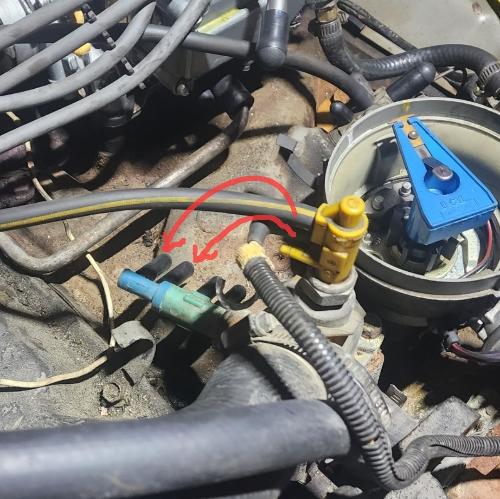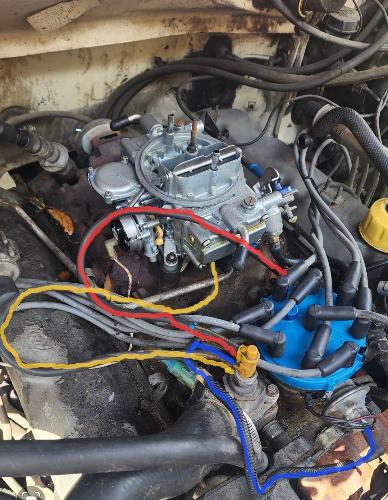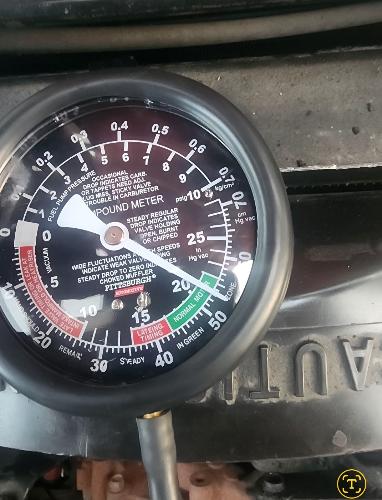Search Forum
1986 460 Smog Pump Delete
12345
12345
|
Speaking of vrest...thanks for explaining what it does. Now, can you confirm where it is? Based on the diagram, I think it's the top port on the yellow vcv valve pictured below, but not sure.
I did more tinkering/learning last night, and tried to run vac lines to the dist adv from one of the manifold ports through the vcv/vrest. The yellow lines on the diagram are what I was trying to do, the blue lines in the pic are what I did. Let me know if the two line up... It idled better, but still bad. The vacuum gauge (hooked to the carb manifold port this time) read around 42 inches. I turned the vac adv clockwise until it was closed, then went 2 turns counterclockwise at a time, it didn't idle good anywhere along the way.   
Jeremy - Oviedo, FL
1986 F250 XLT Lariat Supercab 4x4 Manual 460 |
|
This video should answer a lot of questions about VREST....
https://youtu.be/vZLuqVgxB-M?si=wFFSO3eg3eaTMmQC
Vivek
- BB 2WD - 1984 F350 RWD 460/C6 - 1978 Bronco with a 460 from an 86 Bullnose/C6 |
|
Administrator
|
In reply to this post by Bullnose Gator
Right, the diagram shows the little blue plastic orifice in the line farthest from the threaded end of the VCV.
42" of vacuum is something beyond outer space. Vivek works in semi so I'd differ to him but I don't think it's possible to get beyond 30", and in a truck 22" would be really quite high. You use the distributor wrench to adjust static timing and springs, weights and slots to determine how soon and how much mechanical advance you get as engine rpm increase and vacuum goes away. The vacuum advance is used to adjust how much advance the engine has with the throttle closed. I'd probably be looking for 12° BTDC static, 26-32° with vacuum and 38ish all in, around 3,200 rpm. But my engine is not yours, nor are we going to drive the same, with the same load. You really need to go read the instructions Gary's got posted and follow them step by step (that's important!)
Jim,
Lil'Red is a '87 F250 HD, 4.10's, 1356 4x4, Zf-5, 3G, PMGR, Saginaw PS, desmogged with a Holley 80508 and Performer intake. Too much other stuff to mention. |
|
This post was updated on .
Yes... even getting close to absolute vacuum (nearly 30") needs like 2 cryo pumps... We probably need a picture of your gauge so we can see what you are looking at.. Well nevermind.... I think he is quoting cm Hg. So 42cm Hg = 16.5 " Hg
Vivek
- BB 2WD - 1984 F350 RWD 460/C6 - 1978 Bronco with a 460 from an 86 Bullnose/C6 |
|
In reply to this post by Bullnose Gator
Thanks, V. I probably (definitely) did something wrong. I'll hook the gauge back up and post a pic.
Jim, are you saying I should move the vac lines to the last two darker blue ports, as shown below? Also, I thought Gary was referring me to the last part of those instructions for how to adjust the dist vac adv with the allen wrench, the 2 turns at a time part. Are you saying Scottie's distributor rebuild kit is required, not just recommended? I might go pick up whatever Holly/Edelbrock carb one of the local auto parts stores keep in stock that is closest to one of the ones you recommended tonight. The 4180c obviously wasn't designed for this kind of tuning, or for use without the emissions components and related 2000 feet of vacuum lines. 
Jeremy - Oviedo, FL
1986 F250 XLT Lariat Supercab 4x4 Manual 460 |
|
Administrator
|
No, you're on the right VCV, but you need the distributor coming from the center, the restricted orifice in the outermost port and straight manifold vacuum (code red) to the other port.
The diagram is a graphic representation. I can't draw it any better than the factory. Read the instructions. You need to start at the beginning and complete each step before moving to the next. (I think they are quite clear about this!) Scottie doesn't sell any kit. He sells complete recurved distributors. He has two pages that show how to make those adjustments, but can't explain what adjustments you need to make because every engine/vehicle/use case is different. To make those adjustments you need to understand slot width, use the springs to achieve starting and full advance at the proper rpm for your application, and set the vacuum up so that it's limited just shy of detonation (using whatever fuel and load you intend to deal with) Like Gary, I'm stuck using premium because I don't want to give up performance/acceleration by setting my static lower than 12, and I guess this cam doesn't like lugging.
Jim,
Lil'Red is a '87 F250 HD, 4.10's, 1356 4x4, Zf-5, 3G, PMGR, Saginaw PS, desmogged with a Holley 80508 and Performer intake. Too much other stuff to mention. |
|
In reply to this post by Bullnose Gator
Alright. So a few dummy things I did (I was raised by women, if you haven't assumed by now, bear with me):
1) I thought the VREST was built into the VCV, but then finally had time when I got off to watch the video V shared and understood. I added that back to the line and the original elbow for the dist line. Let me know if I'm still ignorant. 2) Of course, I was reading the wrong side of the gauge. (#FisherPriceMyFirstVacuumGauge) It was actually in the 16-18 inch range, but flickering pretty hard. And that was to start. It got worse (lower) the hotter it got and when I tried to adjust the front idle mixture screws. 3) I'm probably not using the right size vacuum hoses as I try to Frankenstein this together to see what works and what doesn't. Current set up below. I'll have to dig into the timing tomorrow, Jim, but the instructions Gary linked imply replacing springs etc in the distributor, but you say Scottie doesn't sell them. Where do I buy those if I try to do it myself?   
Jeremy - Oviedo, FL
1986 F250 XLT Lariat Supercab 4x4 Manual 460 |
|
You have a rather low vacuum reading if you are running a stock cam... probably need to troubleshoot that...
About the VREST and distributor connections -- the center port of that yellow vacuum control valve needs to be hooked up to the distributor vacuum advance... -- the top port of that control valve connects to intake manifold vacuum port through the VREST -- the bottom port of that control valve connects to intake manifold vacuum straight On my Bronco with the 460... since my vacuum is really stable and good, I don't even use VREST. The distributor is hooked up straight to the intake manifold full-time. About your low vacuum reading... it could be because --- one or two of your cylinders may not be firing --- Your intake to EGR plate / EGR plate to carb gaskets are possibly leaky if you are not using the original style gaskets. You can use the gaskets below which are Felpro's equivalent of the OEM motorcraft ones. I used the ones below on the Bronco and they worked really well. Jim might suggest new old stock OEMs instead. EGR to Carb Gasket - https://www.amazon.com/gp/product/B000C2AD6C/ref=ppx_yo_dt_b_search_asin_title?ie=UTF8&psc=1 Intake to EGR gasket ⦁ https://www.amazon.com/Fel-Pro-60003-Carburetor-Mounting-Gasket/dp/B000C2E4TO
Vivek
- BB 2WD - 1984 F350 RWD 460/C6 - 1978 Bronco with a 460 from an 86 Bullnose/C6 |
|
Administrator
|
This post was updated on .
In reply to this post by Bullnose Gator
Were all here to help one another.
 I don't care if you were raised by girl scouts or wolves, but it's a real challenge to diagnose anything over the internet. We all have to be on the same page. 1) So now you understand why I was saying "the little blue plastic orifice", and didn't mean the blue VCV? By "elbow" do you mean the rubber 90° at the vacuum advance can??? This keeps the routing neat but shouldn't effect function. 2) 16-18, flickering and worse as it gets hot is not good. A gasket leak won't cause jumping, just a low reading Bad intake valves, loose timing chain or an outrageously hot cam with a ton of overlap will. You need to mess with the mixture screws to try and find the highest and most steady vacuum. 3) Hose size really shouldn't matter. Vacuum works on potential, a larger hose should simply add volume to the system, not change anything. Are we looking at the Crane Cams pdf of their adjustable vacuum advance for Ford & Mercury? You understand that you need to be sure the valves and timing chain are in perfect shape before ANY ignition or carburetor adjustments Like I said above the springs come in a set sold by MrGasket (928G) that doesn't seem to be in stock anywhere until the middle of September.. You can get a pair of light springs and use one, but I have one medium and one light in my dizzy.to get some advance in quickly.and all in by 3k Be sure to buy the ones marked Ford/Mercury You may need to weld up the slot or bush the stop ear with a brass tube or piece of plastic fuel line to limit mechanical advance.(Scott says how many thousandths of an inch per degree) Here are some other instructions: https://vb.foureyedpride.com/showthread.php?22229-The-Ultimate-Duraspark-Distributor-Timing-Guide .
Jim,
Lil'Red is a '87 F250 HD, 4.10's, 1356 4x4, Zf-5, 3G, PMGR, Saginaw PS, desmogged with a Holley 80508 and Performer intake. Too much other stuff to mention. |
|
Based on his pics the bottom port of the 3 port VCV seems to be open... might explain why things get worse when hot as there would be no vacuum advance after things get hot.
Jeremy, if that is the case, please connect that bottom port of the VCV straight to the intake manifold ...
Vivek
- BB 2WD - 1984 F350 RWD 460/C6 - 1978 Bronco with a 460 from an 86 Bullnose/C6 |
|
Administrator
|
Okay, now I'm looking at this...
 .... and don't understand how he expects to switch from one vacuum source to the other if there's no line there (crossed out) But that still doesn't explain the pulsing vacuum as the engine warms up. This VCV isn't supposed to open until the engine starts overheating (above 225F or so) If it were the blue VCV that controls EGR and opens as the engine reaches operating temp (like 185-190F) I could grasp why it would make a difference The pulsing thing, I still need to get a handle on. Is it at 16"hg and spikes up? Or is there a pressure spike (vacuum disappears)
Jim,
Lil'Red is a '87 F250 HD, 4.10's, 1356 4x4, Zf-5, 3G, PMGR, Saginaw PS, desmogged with a Holley 80508 and Performer intake. Too much other stuff to mention. |
|
Jim, yep, I understand the VREST is the little blue piece I added to the line. And yes, I added the plastic elbow connecting the center port of the VCV and the vac advance line to the distributor, just because it was there to begin with, I wasn't expecting it to change anything.
Vivek, I'm probably confusing what manifold ports are. Can you define the carb ports below for me? The big one with the arrow to the metal line is the one the pcv was hooked up to, which I detached to hook my vacuum gauge to. Let me know if I'm supposed to be hooking the gauge to the little one below it instead. Also, which one of these should I run the bottom port of the vcv to? 
Jeremy - Oviedo, FL
1986 F250 XLT Lariat Supercab 4x4 Manual 460 |
|
Administrator
|
This post was updated on .
The PCV pipe needs to go to the big nipple in the base* flange, like you had it
The (code red) manifold vacuum should be coming from one of the vacuum trees like your diagram shows, but could go to the small nipple to the left of PCV. The timed vacuum port (E) by the choke would be for EGR and should be capped if you're not using it.
Jim,
Lil'Red is a '87 F250 HD, 4.10's, 1356 4x4, Zf-5, 3G, PMGR, Saginaw PS, desmogged with a Holley 80508 and Performer intake. Too much other stuff to mention. |
|
In reply to this post by Bullnose Gator
Thanks. I ran the bottom vcv port to the carb port on the left of the pcv port, and hooked the gauge to the carb port below the pcv port, (I'm assuming it's the port on the egr spacer). See the orange line in the pic below:
 It started and idled pretty good. Here's the gauge about 30 seconds after cranking it, needle still a little jumpy:  After a few minutes, I decided to try and check the timing. I don't know if it was just a coincidence or not, but a few seconds after I clamped the timing gun leads to the battery, the idle changed in an instant. Immediately the gauge dropped to the pic below. That was right around 5 minutes after starting it: 
Jeremy - Oviedo, FL
1986 F250 XLT Lariat Supercab 4x4 Manual 460 |
|
Administrator
|
Where is your ignition timing set?
8,10,12° BTDC??? How is it with the vacuum advance connected?
Jim,
Lil'Red is a '87 F250 HD, 4.10's, 1356 4x4, Zf-5, 3G, PMGR, Saginaw PS, desmogged with a Holley 80508 and Performer intake. Too much other stuff to mention. |
|
In reply to this post by Bullnose Gator
Bottom port of the vcv needs to go straight to intake manifold your intake should have a 3 or 4-way tree... hook it up to that...
see yellow arrow below 
Vivek
- BB 2WD - 1984 F350 RWD 460/C6 - 1978 Bronco with a 460 from an 86 Bullnose/C6 |
|
Administrator
|
It's 4-way in the front intake runner.
You can see it in his routing diagram.  But it doesn't really matter, as long as it's full manifold vacuum.
Jim,
Lil'Red is a '87 F250 HD, 4.10's, 1356 4x4, Zf-5, 3G, PMGR, Saginaw PS, desmogged with a Holley 80508 and Performer intake. Too much other stuff to mention. |
|
Yes Jim, I agree. Mine is actually hooked up to the Edelbrock full-manifold port.
I saw some ambiguity in the statement "I ran the bottom vcv port to the carb port on the left of the pcv port".... I don't know that carb.... so I just wanted to keep it simple. As long as he is not hooked up to 'E' which is the ported if I am not mistaken, I think it should be fine.
Vivek
- BB 2WD - 1984 F350 RWD 460/C6 - 1978 Bronco with a 460 from an 86 Bullnose/C6 |
|
Administrator
|
You say you have a half dozen 4180's!
 They're pretty much all the same. The one on my 85 GT had 4 corner idle, but these trucks ones don't. Anyway, in the pic above you can see E uncapped Here's all the ports in the carb and spacer: 
Jim,
Lil'Red is a '87 F250 HD, 4.10's, 1356 4x4, Zf-5, 3G, PMGR, Saginaw PS, desmogged with a Holley 80508 and Performer intake. Too much other stuff to mention. |
|
In reply to this post by Bullnose Gator
To remove any doubt, I moved the bottom port of the vcv from the carb port to a port on the exhaust manifold tree. It seemed to run better there too. I marked the crank pully at 0, 10, 20, as best I could (i need to get a more visible marker) and with the timing gun set at 0 it was reading around 20, but looked like it was bouncing a little back and forth.
I ended up turning the dist vac advance with the Allen wrench all the way clockwise (is that fully closed?) And that was the best it ran. The 20 mark stabilized much better under the timing gun. I then adjusted the idle screw to get to 800 rpms. I did NOT remember to clamp the dist vac adv hose, per the ford instructions below during this process though, sadly. I'll have to try again, I assume. Here's the gauge after those adjustments:  
Jeremy - Oviedo, FL
1986 F250 XLT Lariat Supercab 4x4 Manual 460 |
Bullnose Enthusiasts Forum
|
1 view|%1 views
| Edit this page |

